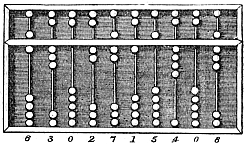| Este artigo é parte da série en:History of computing |
| História do hardware (antes de 1960) |
| História do hardware (de 1960 até hoje) |
| História dos sistemas operacionais |
O hardware do Computador é um componente essencial no processo de cálculo e armazenamento de dados pois ele é necessário para o processamento e compartilhamento de dado. O primeiro computador que se tem notícia é literalmente duro. Os Fenícios armazenavam formas cerâmicas representando coisas como estoque e grãos em vasilhames, que não eram usados apenas pelo mercador mas pelos contadores e oficiais do governo.
Este texto apresenta os fatos mais significativos no desenvolvimento do hardware do computador.
Primeiros dispositivos para facilitar o cálculo
A Humanidade tem utilizado dispositivos para auxiliar a computação a milênios. Um examplo é o dispositivo para estabelecer a igualdade pelo peso: as clássicas balanças, posteriormente utilizadas para simbolizar a igualdade na justiça. Um dispositivo mais orientado à aritmética é o ábaco mostrado na figura ao lado.
Primeiras calculadoras mecânicas
Em 1623 Wilhelm Schickard construiu a primeira calculadora mecânica e assim, tornou-se o pai da era da computação. Como sua máquina utilizava técnicas como engrenagens inicialmente desenvolvidas para relógios, ela foi também chamada de 'relógio calculador'. Ela foi colocada em uso prático por seu amigo [Johannes Kepler]], que revolucionou a astronomia.
A máquina de Blaise Pascal (a Pascalina, 1640) e Gottfried Wilhelm von Leibniz (1670) se seguiram.
Leibniz descreveu também o código binário, um ingrediente central de todos os computadores modernos. Entretanto, até 1940, muitos projetos (incluindo a máquina de Babbage do século 19 e mesmo o ENIAC de 1945) foram baseados no sistema decimal, mais difícil de implementar.
John Napier notou que a multiplicação e a divisão de números poderia ser feita pela adição e subtracão, respectivamente, de logaritmos destes números. Como números reais podem ser representados pelas distâncias ou intervalos em uma linha, uma simples operação de translação ou movimentação de dois pedaços de madeira, corretamente marcados com intervalos logaritmos ou lineares, foi utilizada como a régua de cálculo por gerações de engenheiros e outros profissionais de ciências exatas, ate a invenção da calculadora de bolso . Assim os engenheiros do programa Apollo para enviar o homem à lua fizeram seus cálculos em réguas de cálculo.
Leitores de cartões perfurados 1801-1940
Em 1801, Joseph-Marie Jacquard desenvolveu uma máquina têxtil em que o padrão de saída era controlado por cartões perfurados. O conjunto de cartões poderia ser alterado sem alterar a estrutura da máquina têxtil. Este foi um marco na programação.
Em 1890 o censo dos Estados Unidos utilizou cartões perfurados e máquinas de ordenação desenhadas por Herman Hollerith para controlar os dados do censo da década conforme previsto na constituição. A compania de Hollerith tornou-se posteriormente o núcleo da IBM.
No século 20, a eletricidade foi utilizada pela primeira vez em máquinas de calcular e ordenar. Em 1940, W.J. Eckert do Thomas J. Watson Astronomical Computing Bureau da Universidade de Columbia publicou o artigo Método dos cartões perfurados na computação científica que era suficientemente avançado para resolver equações diferenciais, multiplicar e dividir números de ponto flutuante, baseado unicamente em cartões perfurados e mesas de conexão similares as utilizadas por operadoresed de telefonia. Os cálculos astrônomicos representaram o estado da arte na computação.
Primeiras projetos de máquinas programáveis 1835-1900s
A característica que define um "Computador Universal" é a "programabilidade" que permite ao computador emular qualquer outra máquina de calcular alterando a sequência de instruções armazenadas. Em 1935 Charles Babbage descreve sua Máquina Analítica. Esta máquina tratava-se de um projeto de um computador programável de propósito geral, empregando cartões perfurados para entrada e uma máquina de vapor para fornecer energia. Enquanto os projetos estavam provavelmente corretos, conflitos com o artesão que construia as partes, e o fim do financiamento do governo, tornaram impossivel a sua construção. Ada Lovelace, filha de Lord Byron, traduziu e adicionou anotações ao Desenho da Máquina Analítica de L. F. Manabrea. Ela se tornou uma parceira bem próxima de Babbage. Alguns reinvindicam que ela é a primeira programadora de computadores do mundo, entretando essa reinvindicação e a validade de suas outras contribuições são disputadas por muitos. A reconstrução da Máquina Diferencial está em operação desde 1991 no Museu de Ciências de Londres, ela trabalha como Babbage projetou e mostra que ele estava certo na teoria e permite a produção de partes da precisão requerida. Babbage falhou porque seus desenhos eram muito ambiciosos, ele teve problemas com relações de trabalho, e era politicamente inapto.
Outros tipos limitados de computação mecânica 1800s-1900s
No início do século 20 as primeiras calculadoras mecânicas, caixas registradoras e máquinas de cálculo em geral foram redesenhadas para utilizar motores elétricos, com a posição das engrenagens representando o estado de uma variável. Pessoas eram os calculadores , e utilizavam calculadoras para avaliar expressões. Durante o Projeto Manhattan, o o futuro prêmio Nobel Richard Feynman foi o supervisor de uma sala cheia de calculadores humanos, muitos deles mulheres matemáticas, que entendiam as equações diferenciais que estavam sendo solucionadas para a guerra. Mesmo o renomado Stanislaw Marcin Ulam foi encarregado de trabalhar na tradução da matemática em um modelo computacional aproximado da bomba de hidrogênio, depois da guerra.
Durante a Segunda guerra mundial, Os planos de Curt Herzstark para uma calculadora mecânica de bolso literalmente salvaram sua vida. Veja: Cliff Stoll, Scientific American 290, no. 1, pp. 92-99. (Janeiro 2004)
Computadores analógicos, pré-1940
Antes da segunda guerra, computadores mecânicos e elétricos computadores analógicos foram considerados o 'estado da arte', e muitos pensavam que eles eram o futuro da computação. Computadores analógicos utilizam variações contínuas de variáveis físicas, como voltagem e corrente, ou a velocidade de rotação de um dispositivo, para representar as quantidades sendo processadas. Um exemplo ingênuo de tal máquina é o Integrator aquático construído em 1936. Ao contrário dos computadores digitais modernos, computadores analógicos não são muito flexíveis, e precisavam ser reconfigurados (reprogramados) manualmente para trocar o problema em que iriam trabalhar. Computadores analógicos tinham uma vantagem frente aos primeiros computadores digitais pois eram capazes de resolver problemas mais complexos. Desde que os programas de computador não eram ainda muito populares nesta época (apesar do trabalho pioneiro de Babbage), As soluções eram freqüêntemente hard-coded na forma de gráficos and nomogramas, que podiam representar, por exemplo, uma analogia da solução de problemas como a distribuição de pressão e temperatura em um sistema de aquecimento. Mas a medida que os computadores digitais se tornavam mais rápidos e com mais memória (e.g., RAM ou armazenamento interno), eles praticamente substituiram inteiramente os computadores analógicos, e a profissão de programador surgiu.
First generation of modern digital computers 1940s
The era of modern computing began with a flurry of development before and during World War II, as electronic circuits, relays, capacitors and vacuum tubes replaced mechanical equivalents and digital calculations replaced analog calculations. The computers designed and constructed then have sometimes been called 'first generation' computers. First generation computers were usually built by hand using circuits containing relays or vacuum valves (tubes), and often used punched cards or punched paper tape for input and as the main (non-volatile) storage medium. Temporary, or working storage, was provided by acoustic delay lines (which use the propagation time of sound in a medium such as wire to store data) or by Williams tubes (which use the ability of a television picture tube to store and retrieve data). By 1954, magnetic core memory was rapidly displacing most other forms of temporary storage, and dominated the field through the mid-1970s.
In 1936 Konrad Zuse started construction of the first Z-series, calculators featuring memory and (initially limited) programmability. Zuse's purely mechanical, but already binary Z1, finished in 1938, never worked reliably due to problems with the precision of parts.
In 1937, Claude Shannon produced his master's thesis at MIT that implemented Boolean algebra using electronic relays and switches for the first time in history. Entitled A Symbolic Analysis of Relay and Switching Circuits, Shannon's thesis essentially founded practical digital circuit design.
Zuse's subsequent machine, the Z3, was finished in 1941. It was based on telephone relays and did work satisfactorily. Z3 thus became the first functional program-controlled computer. In many ways it was quite similar to modern machines, pioneering numerous advances, such as the use of binary arithmetic and floating point numbers. Replacement of the hard-to-implement decimal system (used in Charles Babbage's earlier design) by the simpler binary system meant that Zuse's machines were easier to build and potentially more reliable, given the technologies available at that time. This is sometimes viewed as the main reason why Zuse succeeded where Babbage failed, however, most of today's general purpose machines continue to have decimal adjustment instructions, decimal arithmetic is still essential for commercial and financial applications, and decimal floating-point hardware is being added to some new machines (binary continues to be used for addressing in almost all machines).
Programs were fed into Z3 on punched films. Conditional jumps were missing, but since the 1990s theoretical purists have pointed out that Z3 was still a universal computer (ignoring its physical storage size limitations). In two 1937 patents, Konrad Zuse also anticipated that machine instructions could be stored in the same storage used for data - the key insight of what became known as the Von Neumann architecture and was first implemented in the later British EDSAC design (1949). Zuse also designed the first higher-level programming language, (Plankalkül), in 1945, although it was never formally published until 1971, and was implemented for the first time in 2000 by the University of Berlin -- five years after Zuse died.
Zuse suffered dramatical setbacks and lost many years during World War II when British or American bombers actually destroyed his first machines. Apparently his work remained largely unknown to engineers in the UK and US until much later, although at least IBM was aware of it as it financed his post-war startup company in 1946 in return for an option on Zuse's patents.
In 1940, the Complex Number Calculator, a calculator for complex arithmetic based on relays, was completed. It was the first machine ever used remotely over a phone line. In 1938 John Vincent Atanasoff and Clifford E. Berry of Iowa State University developed the Atanasoff Berry Computer (ABC), a special purpose computer for solving systems of linear equations, and which employed capacitors fixed in a mechanically rotating drum, for memory. The ABC machine was not programmable, though it was a computer in the modern sense in several other respects.
During World War II, the British made significant efforts at Bletchley Park to break German military communications. The main German cypher system (the Enigma in several variants) was attacked with the help of purpose built 'Bombes' (designed after Polish programmable electro-mechanical 'Bombas') which helped find possible Enigma keys after other techniques had narrowed down the possibilities. The Germans also developed a series of cypher systems (called Fish cyphers by the British and Lorenz cyphers by the Germans) which were quite different than the Enigma. As part of an attack against these cyphers, Professor Max Newman and his colleagues (including Alan Turing) helped specify the Colossus. The Mk I Colossus was built in very short order by Tommy Flowers at the Post Office Research Station at Dollis Hill in London and then shipped to Bletchley Park.
Colossus was the first totally electronic computing device. The Colossus used only vacuum tubes and had no relays. It had paper-tape input and was capable of conditional branching. Nine Mk II Colossi were built (The Mk I was converted to a Mk II making ten machines in total). Details of their existence, design, and use were kept secret well into the 1970s. Winston Churchill is said to have personally issued an order for their destruction into pieces no larger than a man's hand. Due to this secrecy the Colossi were not included in many histories of computing. A reconstructed copy of one of the Colossus machines is now on display at Bletchley Park.
Turing's pre-War work was a major influence on theoretical computer science, and after the War he went on to design, build and program some of the earliest computers at the National Physical Laboratory and at the University of Manchester. His 1936 paper included a reformulation of Kurt Gödel's 1931 results as well as a description of what is now called the Turing machine, a purely theoretical device invented to formalize the notion of algorithm execution, replacing Gödel's more cumbersome universal language based on arithmetics. Modern computers are Turing-complete (i.e., equivalent algorithm execution capability to a universal Turing machine), except for their finite memory. This limited type of Turing completeness is sometimes viewed as a threshold capability separating general-purpose computers from their special-purpose predecessors.
George Stibitz and colleagues at Bell Labs in NY City produced several relay based 'computers' in the late '30s and early '40s, but were concerned mostly with problems of telephone system control, not computing. Their efforts were a clear antecedent for another electromechanical American machine, however.
The Harvard Mark I (officially, the Automatic Sequence Controlled Calculator) was a general purpose electro-mechanical computer built with IBM financing and with assistance from some IBM personnel under the direction of Harvard mathematician Howard Aiken. Its design was influenced by the Analytical Engine. It was a decimal machine which used storage wheels and rotary switches in addition to electromagnetic relays. It was programmable by punched paper tape, and contained several calculators working in parallel. Later models contained several paper tape readers and the machine could switch between readers based on a condition. Nevertheless, this does not quite make the machine Turing-complete. Development began in 1939 at IBM's Endicott laboratories; the Mark I was moved to Harvard University to begin operation in May 1944.
The US-built ENIAC (Electronic Numerical Integrator and Computer), often called the first electronic general-purpose computer, publicly validated the use of electronics for large-scale computing. This was crucial for the development of modern computing, initially because of the enormous speed advantage, but ultimately because of the potential for miniaturization. Built under the direction of John Mauchly and J. Presper Eckert, it was 1,000 times faster than its contemporaries. ENIAC's development and construction lasted from 1941 to full operation at the end of 1945. When its design was proposed, many researchers believed that the thousands of delicate valves (ie, vacuum tubes) would burn out often enough that the ENIAC would be so frequently down for repairs as to be useless. It was, however, capable of up to 100,000 simple calculations a second for hours at a time between valve failures.
To `program' ENIAC, however, meant to rewire it - some say, this does not even qualify as programming, otherwise any type of rebuilding some limited computer might be viewed as programming. Several years later, however, it became also possible to execute stored programs set in function table memory.
All machines at that date still lacked what became known as the von Neumann architecture: their programs were not stored in the same memory 'space' as the data and hence programs could not be manipulated as data.
The first working von Neumann machine was the Manchester "Baby" or Small-Scale Experimental Machine, built at the University of Manchester in 1948; it was followed in 1949 by the Manchester Mark I computer which functioned as a complete system using the Williams tube for memory, and also introduced index registers. The other contender for the title "first digital stored program computer" was EDSAC, designed and constructed at the University of Cambridge. Operational less than one year after the Manchester "Baby", it was capable of tackling real problems. EDSAC was actually inspired by plans for EDVAC, the successor of ENIAC; these plans were already in place by the time the ENIAC was successfully operational. Unlike the ENIAC, which used parallel processing, EDVAC used a single processing unit. This design was simpler and was the first to be implemented in each succeeding wave of miniaturization, and increased reliability. Some view Manchester Mark I / EDSAC / EDVAC as the "Eves" from which nearly all current computers derive their architecture.
The first universal programmable computer in continental Europe was created by a team of scientists under direction of Segrey Alekseevich Lebedev from Institute of Electrotechnology in Kiev, Soviet Union (now Ukraine). The computer MESM (МЭСМ, Small Electronic Calculating Machine) became operational in 1950. It had about 6,000 vacuum tubes and consumed 25 kW of power. It could perform approximately 3,000 operations per second.
Manchester University's machine became the prototype for the Ferranti Mark I. The first Ferranti Mark I machine was delivered to the University in February, 1951 and at least nine others were sold between 1951 and 1957.
In June 1951, the UNIVAC I (Universal Automatic Computer) was delivered to the U.S. Census Bureau. Although manufactured by Remington Rand, the machine often was mistakenly referred to as the "IBM UNIVAC". Remington Rand eventually sold 46 machines at more than $1 million each. UNIVAC was the first 'mass produced' computer; all predecessors had been 'one-off' units. It used 5,200 vacuum tubes and consumed 125 kW of power. It used a mercury delay line capable of storing 1,000 words of 11 decimal digits plus sign (72-bit words) for memory. Unlike earlier machines it did not use a punch card system but a metal tape input.
In November 1951, the J. Lyons company began weekly operation of a bakery valuations job on the LEO (Lyons Electronic Office). This was the first business application to go live on a stored program computer.
Also in 1951 (July), Remington Rand demonstrated the first prototype of the 409, a plugboard-programmed punch card calculator. This was first installed, at the Internal Revenue Service facility in Baltimore, in 1952. See the Rowayton Historical Society's timeline (and other documents at that site) for details. The 409 evolved to become the Univac 60 and 120 computer in 1953.
Second generation 1947-1960
The next major step in the history of computing was the invention of the transistor in 1947. This replaced the fragile and power hungry valves with a much smaller and more reliable component. Transistorised computers are normally referred to as 'Second Generation' and dominated the late 1950s and early 1960s. Despite using transistors and printed circuits these computers were still large and primarily used by universities, governments, and large corporations. For example the vacuum tube based IBM 650 of 1954 weighed over 900 kg, the attached power supply weighed around 1350 kg and both were held in separate cabinets of roughly 1.5 meters by 0.9 meters by 1.8 meters. It cost $500,000 or could be leased for $3,500 a month. However the drum memory was originally only 2000 10-digit words, a limitation which forced arcane programming, to allow responsive computing. This type of hardware limitation was to dominate programming for decades afterward, until the evolution of a programming model which was more sympathetic to software development.
In 1955, Maurice Wilkes invented microprogramming, now almost universally used in the implementation of CPU designs. The CPU instruction set is defined by a type of programming.
In 1956, IBM sold its first magnetic disk system, RAMAC (Random Access Method of Accounting and Control). It used 50 24-inch metal disks, with 100 tracks per side. It could store 5 megabytes of data and cost $10,000 per megabyte.
The first implemented high-level general purpose programming language, FORTRAN, was also being developed at IBM around this time. (Konrad Zuse's 1945 design of the high-level language Plankalkül was not implemented at that time.)
In 1959 IBM shipped the transistor-based IBM 1401 mainframe, which used punch cards. It proved a popular general purpose computer and 12,000 were shipped, making it the most successful machine in computer history. It used a magnetic core memory of 4000 characters (later expanded to 16,000 characters). Many aspects of its design were based on the desire to replace punched card machines which were in wide use from the 1920s through the early 70s.
In 1960 IBM shipped the transistor-based IBM 1620 mainframe, originally with only punched paper tape, but soon upgraded to punch cards. It proved a popular scientific computer and about 2,000 were shipped. It used a magnetic core memory of up to 60,000 decimal digits.
Also in 1960, DEC launched the PDP-1 their first machine intended for use by technical staff in laboratories and for research.
In 1964 IBM announced the S/360 series, which was the first family of computers that could run the same software at different combinations of speed, capacity and price. It also pioneered the commercial use of microprograms, and an extended instruction set designed for processing many types of data, not just arithmetic. In addition, it unified IBM's product line, which prior to that time had included both a "commercial" product line and a separate "scientific" line. The software provided with System/360 also included major advances, including commercially available multi-programming, new programming languages, and independence of programs from input/output devices. Over 14,000 System/360 systems were shipped by 1968.
Also in 1964, DEC launched the PDP-8 much smaller machine intended for use by technical staff in laboratories and for research.
Terceira geração e posterior, após-1958
A explosão no uso dos computadores começou com a 'Terceira Geração' de computadores. Estes se baseiam na invenção independente do circuito integrado (ou chip) por Jack St. Claire Kilby e Robert Noyce, que posteriormente levou à invenção do microprocessador por Ted Hoff da Intel.
A História do hardware nos países comunistas foi um pouco diferente.
No final da década de 1950, pesquisadores como George Gamow notaram que longas seqüências de nucleotídeos no DNA formavam um código genético, assim surge uma outra forma de codificação ou programação, desta vez com expressões genéticas. Na década de 1960, foi identificado análogos para a instrução de parada halt, por exemplo.
Na virada do milênio, pesquisadores notaram que o modelo descrito pela física quântica ...
See also
- Computing timeline
- History of operating systems
- History of the Internet
- History of the graphical user interface
- Programming language timeline
- Computers in fiction
External links
- Stephen White's excellent computer history site (the above article is a modified version of his work, used with Permission)
- Yahoo Computers and History
- Paul Pierce's computer collection
- IEEE computer history timeline
- Konrad Zuse, inventor of first working programmable digital computer
- The story of the Manchester Mark I, 50th Anniversary web site at the University of Manchester
- The Moore School Lectures and the British Lead in Stored Program Computer Development (1946 -1953), article from Virtual Travelog
- Logarithmic timeline of greatest breakthroughs since start of computing era in 1623
- Rowayton Historical Society's Birthplace of the World's First Business Computer
- OLD-COMPUTERS.COM, extensive collection of information and pictures about old computers
nl:Geschiedenis van de computer pl:Historia informatyki sv:Datorhistoria en:History of computing hardware









 " class="attachment-atbs-s-4_3 size-atbs-s-4_3 wp-post-image" alt="O que estudar para o enem 2023">
" class="attachment-atbs-s-4_3 size-atbs-s-4_3 wp-post-image" alt="O que estudar para o enem 2023"> " class="attachment-atbs-s-4_3 size-atbs-s-4_3 wp-post-image" alt="Qual melhor curso para fazer em 2023">
" class="attachment-atbs-s-4_3 size-atbs-s-4_3 wp-post-image" alt="Qual melhor curso para fazer em 2023"> " class="attachment-atbs-s-4_3 size-atbs-s-4_3 wp-post-image" alt="Enem: Conteúdos E Aulas On-Line São Opção Para Os Estudantes">
" class="attachment-atbs-s-4_3 size-atbs-s-4_3 wp-post-image" alt="Enem: Conteúdos E Aulas On-Line São Opção Para Os Estudantes"> " class="attachment-atbs-s-4_3 size-atbs-s-4_3 wp-post-image" alt="Como Fazer Uma Carta De Apresentação">
" class="attachment-atbs-s-4_3 size-atbs-s-4_3 wp-post-image" alt="Como Fazer Uma Carta De Apresentação"> " class="attachment-atbs-s-4_3 size-atbs-s-4_3 wp-post-image" alt="Como Escrever Uma Boa Redação">
" class="attachment-atbs-s-4_3 size-atbs-s-4_3 wp-post-image" alt="Como Escrever Uma Boa Redação"> " class="attachment-atbs-s-4_3 size-atbs-s-4_3 wp-post-image" alt="Concurso INSS edital 2022 publicado">
" class="attachment-atbs-s-4_3 size-atbs-s-4_3 wp-post-image" alt="Concurso INSS edital 2022 publicado">


